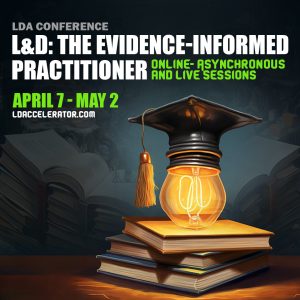On my walk today, I was pondering the Evidence-informed Practitioner (EIP) conference (rapidly approaching, hence the top-of-mind positioning). And, I was looked at it a different way. Not completely, but enough. So, I thought I’d share those thoughts with you, as a possible answer to “why the EIP conference?”
To start, the conference was created to fill the gap articulated at our Learning Science conference. To wit, “this is all well and good, but how do we do it in practice?” Which, as I’ve opined, is a fair question. And we resolved to answer that.
I started with pondering, while perambulating, about the faculty. We’ve assembled folks who’ve been there, done that, know the underpinnings, and are articulate at sharing. Sure, we could ask people to submit proposals, but instead we went out and searched for the folks we thought would do this best.
My cogitations went further. What would be the best way for folks to get the answers they need? And, of course, the best is mentored live practice…like most learning would be. And, like most learning, that’s not necessarily practical to organize nor affordable. So, what’s the next best thing?
You could do uni courses in it all. You could read books about it all. Or, you could have a focused design. That is, first you have the best folks available create presentations about it. Then, have discussion forums available to answer the questions that arise. With the presenters participating. Finally, you have live sessions at accessible times to consolidate the content and discussions. Again, with the presenters hosting.
That last is what we’ve actually done. That’s what my reflection told me; this is pretty much the best way to get practical advice you can put into practice right away, and refine it. At least, the best value. From the time the videos are available ’til the live sessions, you have a chance to put what’s relevant to you into practice – that is, try it out – and have experts around to share what you’ve learned and answer the emergent questions!
Let’s be clear. Most confs have presentations and time to talk to the presenters, but not the time between presentations and scheduled discussion to try things out. Here, between my co-director Matt Richter and myself, we created a pedagogy that works.
Further, I got to choose the curriculum, starting with what most folks do (design courses), and then branch out from there: first, the barriers, then forward to analysis, and back to evaluation. Then we go broader, talking about extending learning via motivation and coaching, resources for continuing to learn, technology, and move to not learning via performance support. Finally we on to org-spanning issues including innovation and culture.
This is the right stuff to know, and an almost ideal way to learn it, in a practical format. It’s all asynchronous so you can do it at your own schedule, except for the live sessions, and for each they’re each offered at two different times to increase the likelihood that you can attend the ones you want to. Of course, they’re all taped as well.
But wait, there’s more! (Always wanted to say that. ;) If you order now, using the code EIP10CQ, you get 10% off! That makes a great deal become exceptional! Ok, so I’m laying it on a bit thick, but we really did try to make this the gala event of the season, and a valuable learning experience. So, I hope to see you there. Anyways, that’s my answer to why the EIP conference.
